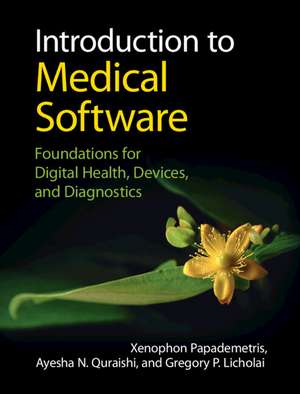Introduction to Medical Software: Foundations for Digital Health, Devices, and Diagnostics: Cambridge Texts in Biomedical Engineering
Autor Xenophon Papademetris, Ayesha N. Quraishi, Gregory P. Licholaien Limba Engleză Hardback – 4 mai 2022
Din seria Cambridge Texts in Biomedical Engineering
- 5%
 Preț: 397.76 lei
Preț: 397.76 lei - 5%
 Preț: 442.22 lei
Preț: 442.22 lei - 5%
 Preț: 573.97 lei
Preț: 573.97 lei - 5%
 Preț: 409.25 lei
Preț: 409.25 lei - 5%
 Preț: 689.10 lei
Preț: 689.10 lei - 5%
 Preț: 522.91 lei
Preț: 522.91 lei - 11%
 Preț: 486.77 lei
Preț: 486.77 lei - 5%
 Preț: 905.93 lei
Preț: 905.93 lei -
 Preț: 441.45 lei
Preț: 441.45 lei - 5%
 Preț: 825.18 lei
Preț: 825.18 lei - 5%
 Preț: 872.98 lei
Preț: 872.98 lei - 5%
 Preț: 841.29 lei
Preț: 841.29 lei - 5%
 Preț: 874.27 lei
Preț: 874.27 lei - 5%
 Preț: 583.21 lei
Preț: 583.21 lei - 5%
 Preț: 845.07 lei
Preț: 845.07 lei - 11%
 Preț: 606.71 lei
Preț: 606.71 lei - 5%
 Preț: 621.35 lei
Preț: 621.35 lei - 5%
 Preț: 654.54 lei
Preț: 654.54 lei - 15%
 Preț: 530.76 lei
Preț: 530.76 lei
Preț: 484.69 lei
Preț vechi: 510.21 lei
-5% Nou
Puncte Express: 727
Preț estimativ în valută:
92.75€ • 99.18$ • 77.33£
92.75€ • 99.18$ • 77.33£
Carte tipărită la comandă
Livrare economică 17 aprilie-01 mai
Preluare comenzi: 021 569.72.76
Specificații
ISBN-13: 9781316514993
ISBN-10: 1316514994
Pagini: 338
Dimensiuni: 193 x 252 x 22 mm
Greutate: 0.82 kg
Ediția:Nouă
Editura: Cambridge University Press
Colecția Cambridge University Press
Seria Cambridge Texts in Biomedical Engineering
Locul publicării:Cambridge, United Kingdom
ISBN-10: 1316514994
Pagini: 338
Dimensiuni: 193 x 252 x 22 mm
Greutate: 0.82 kg
Ediția:Nouă
Editura: Cambridge University Press
Colecția Cambridge University Press
Seria Cambridge Texts in Biomedical Engineering
Locul publicării:Cambridge, United Kingdom
Cuprins
Preface; Part 1. Regulatory, Business and Management Background: 1. Introduction to medical software; 2. The FDA and software; 3. Operating within a healthcare system; 4. Quality management systems; 5. Risk management; 6. Taking an idea to market: understanding the product journey; 7. Medical software applications and growth drivers; Part II. Scientific and Technical Background: 8. Mathematical background; 9. Topics in software engineering; Part III. An Example Medical Software Life Cycle Process: 10. The overall process; 11. Identifying user needs; 12. The system requirements specification; 13. The software design document; 14. Software construction and testing and verification; 15. Software validation; 16. Deployment, maintenance and decommissioning; Part IV. Case Studies: 17. Therac-25: software that killed; 18. Mars Climate Orbiter: lost without a trace; 19. Healthcare.gov: the failed launch of a critical webpage; 20. The 2020 Iowa Caucus app: an unreliable app that caused national embarrassment; 21. The Boeing 737-MAX disasters: using software to fix hardware problems; 22. The averted Y2K crisis: successful crisis and risk management; References; Index.
Notă biografică
Descriere
A concise and accessible overview of the design, implementation and management of medical software.
